Report Authors and Accessibility
Report Authors:
- Matthew May, Survey Research Director, School of Public Service
- Lantz McGinnis-Brown, Research Associate, Idaho Policy Institute
- Vanessa Fry, Director, Idaho Policy Institute
- Elijah Kuisachor, Graduate Assistant, Idaho Policy Institute
Accessibility Statement
Content on this site is monitored for compliance with WCAG 2.0 standards. We are continuously improving the usability of our content and are actively working to provide a more inclusive experience for all. Please, contact the Idaho Policy Institute immediately if you encounter any access barriers, challenges, or require the content in another format to fully access the information.
Report content is available on this page or as a downloadable PDF. An interactive dashboard is also provided. For a list of keyboard shortcuts specific to the Tableau dashboard, please visit Keyboard Accessibility for Tableau Views
To request the topline data and full tab book for any survey, email School of Public Service Survey Research Director Dr. Matthew May at: matthewmay1@boisestate.edu
Download the 9th Annual Statewide Survey (PDF)Read the Ninth Annual Statewide Survey
About the Survey
The Ninth Annual Idaho Public Policy Survey was conducted November 4-14, 2023, and surveyed 1,007 adults who currently live in Idaho. The sample is representative of the state’s population, both geographically and demographically, with a margin of error of +/- 3.1%. Responses were weighted to ensure representativeness of Idaho’s demographics. The survey covered a wide variety of topics, including the economy, taxes, elections, education, growth, housing, and public safety. GS Strategy Group fielded the survey by cell phone (25%), landline phone (25%), online (40%), and text message (10%).
Key Findings
• Education, jobs and the economy, and housing remain Idahoans’ top 3 legislative priorities.
• For the first time in the survey’s history, more Idahoans (43%) feel the state is off on the wrong track.
• Idahoans remain reserved about the economic outlook of the state– split between things staying the same (38%) and getting worse (36%).
• Idahoans continue to be concerned with a range of housing issues and how they affect their own financial situations.
• Newcomers to Idaho within the last 10 years are more likely to identify as Republicans (+11 points), and less likely to identify as Independents (-10 points).
• A majority of Idahoans favor expanding exceptions to Idaho’s abortion law, though they disagree on what those exceptions should be.
• Idahoans trust public libraries and librarians (69%) to choose the books that are made available in them.
• Idahoans favor a primary election (74%) over a caucus (13%) and for U.S. presidential and Idaho state primaries to be held on the same day (74%).
• Idahoans generally favor a top-four primary system but oppose a ranked-choice voting system – only 29% said they would favor both.
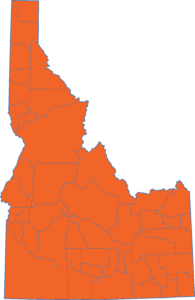
The Idaho Public Policy Survey polled 1,007 Idahoans representing 44 of Idaho’s 44 counties.9th Annual Idaho Public Policy Survey
Overview
Each year, the Idaho Public Policy Survey has asked Idahoans whether they think the state is headed in the right direction or if it is off on the wrong track. Results follow the more pessimistic outlook of recent years, with more respondents saying they feel the state is off on the wrong track (43%) rather than headed in the right direction (40%). While both responses fall within the margin of error like last year, making it a statistical tie, this is the first time in this survey’s history that wrong direction has been the top response among Idahoans. Majorities of both Democrats (58%) and Independents (50%) have a negative view of the state’s direction, while a majority of Republicans (56%) have a positive one. Renters held a pessimistic view by a 15-point margin, while homeowners held a positive view by a three-point margin.
Do you think things in Idaho are generally headed in the right direction, or do you feel that things are off on the wrong track?
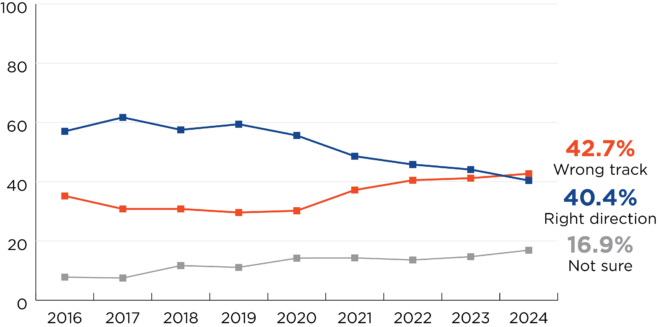
In order to better understand why Idahoans feel the way they do, for the first time an open-ended follow-up question asked respondents why they answered the way they did. These responses were subsequently coded into like categories. Among those who responded the state was headed in the right direction, nearly a quarter (23%) said Idaho was overall a good state or they loved it, while 18% cite the state being conservative as their main reason. Idaho’s leadership and politics (14%) was the third most frequent type of response and managing growth and infrastructure (11%) was fourth. The remaining one-third of responses individually accounted for less than 10% and included explanations such as the economy and jobs, low crime, Idaho’s culture, and the education system, among others.
Why do you think things in Idaho are generally headed in the right direction? [open ended] Top 5 Response Categories
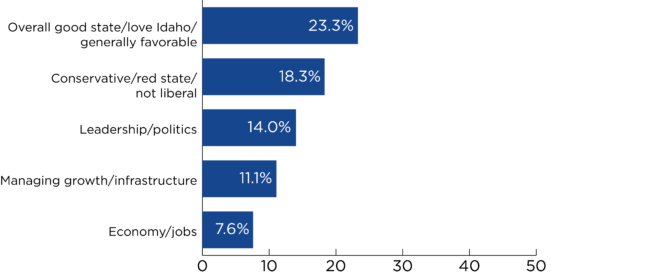
Conversely, among those who responded that the state was off on the wrong track, there was less overall agreement on why. The state’s conservatism and Republican supermajority was the top response among pessimists (15%), followed by the cost of living and the economy (12%). Almost as many cited those moving to Idaho from other areas and the differing values they bring (12%) and Idaho’s politicians and the state’s leadership (12%). The remaining half of responses all individually fell below 10% each, and included the state becoming too liberal, too much population growth, abortion issues, extremism, and the state’s education and funding of schools.
Why do you think things in Idaho are generally off on the wrong track? [open ended] Top 5 Response Categories
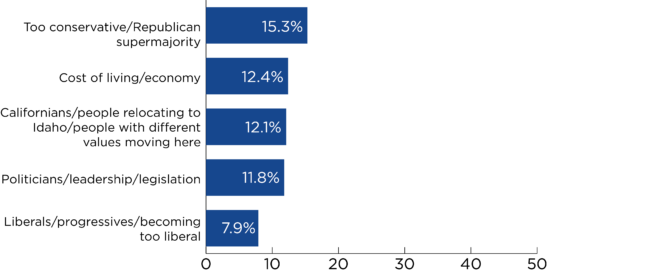
Idahoans also remain somewhat pessimistic when it comes to whether they expect economic conditions over the next two years in Idaho to get better, worse, or stay the same. The largest group of Idahoans expect economic conditions to stay the same (38%), while nearly as many expect things to get worse (36%). A little less than one in five Idahoans (19%) expect things to get better, while the rest are unsure (7%). Most of the change compared to last year falls within the margin of error. In contrast to their more positive attitudes about the direction of the state, Independents (38%) and Republicans (36%) generally expect economic conditions to get worse, while most Democrats (45%) expect things to stay the same.
Over the next two years, do you expect the economic condition in Idaho to get better, worse, or stay about the same?
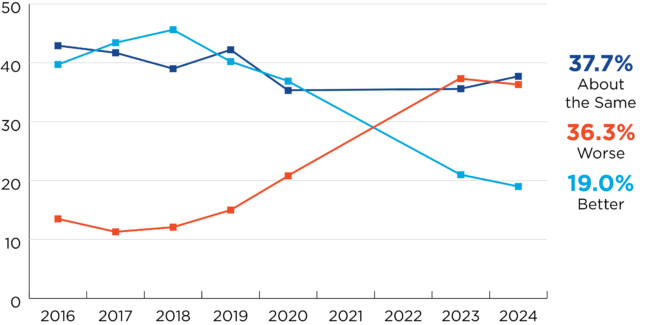
When asked what about the economy they are most concerned about, Idahoans overwhelmingly said the cost of living and inflation (74%) was their main concern, with interest rates and housing (16%) a distant second. A small number noted the availability of jobs (4%) or the stock market (2%). While the cost of living and inflation was the top response regardless of Idahoans’ economic outlook, it was a more pronounced concern among those who expected economic conditions to get worse (81%) or stay the same (73%) than among those who expected conditions to get better (65%). Similarly, those who expected conditions to get better were more likely to be concerned about interest rates and housing (21%) than those who saw things getting worse (12%) or staying the same (17%).
What part of the economy are you personally most concerned about?
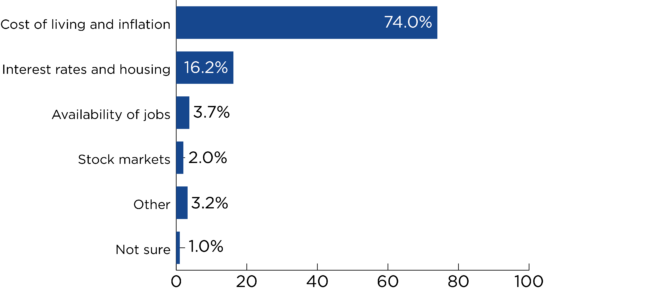
Each year, Idahoans are asked to rate policy areas on a scale of 1-10 in terms of how important it is that the Idaho Legislature address that particular issue during the legislative session (1 being not at all important and 10 being extremely important). Topics include education, the environment, healthcare, housing, jobs and the economy, taxes, and transportation. Respondents were not asked about specific policy preferences in these questions, only which areas they felt warranted the legislature’s attention.
On a scale of 1-10, with 1 being not at all important and 10 being extremely important, please indicate how important it is for the Idaho State Legislature to address each of the following issues? (% scoring 8-10)
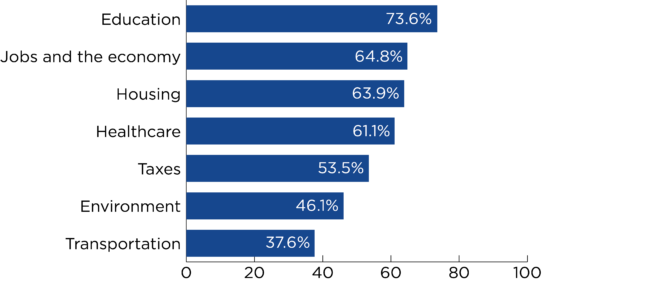
The proportion of Idahoans scoring issues 8-10 mostly fall within the margin of error compared to last year, with the overall ordering remaining unchanged. Education has consistently been the highest ranked legislative priority for all nine years of this survey, with 74% scoring it 8-10. It was also the top-ranked priority for Republicans (71%), Independents (77%), and Democrats (77%).
The second highest priority remains jobs and the economy, a position it has held for five years, with 65% of Idahoans identifying it as a high priority. It was the second highest priority among Republicans (68%), the third among Independents (64%), and the fifth among Democrats (64%).
Continuing a trend from recent years, housing (64%) was the third highest priority, only narrowly missing out on rising to the second highest overall. It was the second highest priority among both Democrats (75%) and Independents (66%) and the fourth highest among Republicans (59%).
Healthcare (61%) was the fourth highest priority overall. It was the third highest among Democrats (74%), fourth highest among Independents (63%), and fifth highest among Republicans (55%).
Taxes (54%) was once again the fifth highest priority overall. It came in third among Republicans (59%), fifth among Independents (52%), and last among Democrats (47%).
The environment (46%) was sixth overall, showing a five-point decrease compared to last year that was outside the margin of error. It was the fourth highest priority among Democrats (71%), sixth highest among Independents (49%), and lowest priority among Republicans (32%).
Finally, transportation (38%) remains the lowest ranked priority, a position it has held for the past nine years. The proportion of Idahoans scoring it 8-10 declined five-points compared to last year, again outside the margin of error. It was the sixth highest priority among both Republicans (34%) and Democrats (49%) and the lowest priority among Independents (35%).
Decisions at all levels of government have the ability to impact Idahoans’ daily lives, whether city, county, state, or national government. Given this, we asked Idahoans to identify which level of government they trust the most. A third of Idahoans said they did not trust any level of government (33%). Cities (20%) had the most trust, followed by the state (16%) and county (16%). Only 5% said the national government, while 3% said they trusted all levels of government.
In your opinion, which level of government do you trust the most?
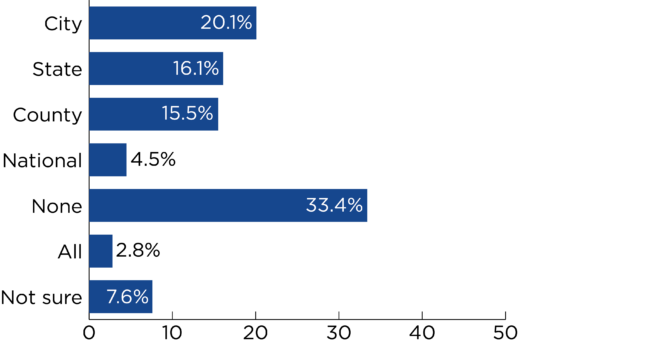
Policy Preferences
Budgets and taxes are two things Idahoans often have strong opinions on. In prior years, we have asked them to identify their top spending priority for projected budget surpluses using specific dollar amounts. Given the variability in whether or not the state will have a budget surplus, the wording of this question is now generalized to simply identify a spending priority and to allow greater comparability of results over time.
When asked, Idahoans identified workforce and affordable housing (38%) as the top budget priority for 2024, reflecting increased concerns surrounding housing issues over the past several years. As a caveat, we asked three housing questions prior to this, which may have impacted results by placing housing at the top of respondents’ minds. Idahoans’ next highest priorities are funding K-12 education (24%) and giving tax relief to Idahoans (22%), followed by transportation and infrastructure (7%) or something else (6%).
Which of the following should be the top priority for Idaho’s legislature when considering the state budget in 2024?
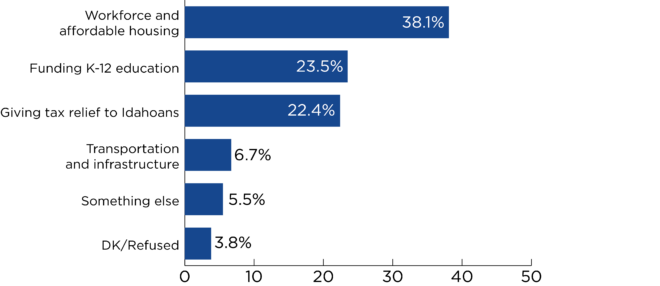
Workforce and affordable housing was the top spending priority among all political parties– Democrats (42%), Independents (39%) and Republicans (34%). It was also the top spending priority among those who said the state was off on the wrong track by eight-points, among renters by 23-points, and among women by 19-points. While funding K-12 is the second highest spending priority among Democrats (31%) and Independents (27%), it was the third highest for Republicans (18.4%). Instead, Republicans favored tax relief (30%) as their second highest priority, which came in third highest for Democrats (11%) and Independents (19%).
We once again asked Idahoans to identify which type of tax relief they would most prefer. Idahoans’ preference for tax relief is largely unchanged compared to last year, falling within the margin of error. Property tax (39%) remains the most preferred type for tax relief, followed by income tax (33%) and sales tax (21%). Property tax was the top response among all party identifications– Republicans (40%), Democrats (40%), and Independents (38%).
If you were to see a form of tax relief in the next year, which type of tax should be reduced to provide the most help to Idahoans during this time?
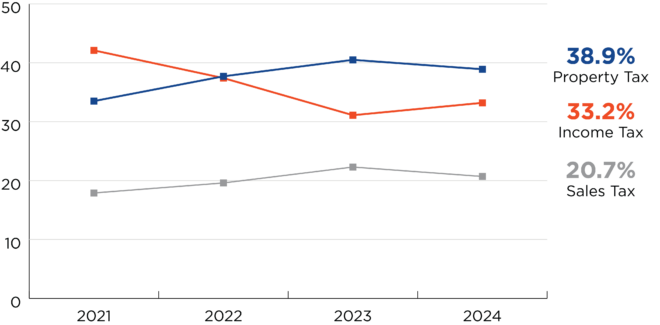
Home ownership once again had a strong impact on a person’s tax relief preference, with homeowners favoring property tax relief by a 19-point margin and renters favoring income tax relief by a 21-point margin. Age also impacted one’s preference, with those aged 18-39 favoring income tax relief (44%) by a wide margin, while those aged 65 and older favor property tax relief (52%) by an equally large margin.
Idahoans remain very concerned about property tax levels in the state. A majority (59%) say that property taxes are too high, while 28% say they are about right. Only 2% say they are too low. Compared to last year, most of the movement on this question is within the margin of error. This suggests the rapid increase of the margin between too high and about right compared to four years ago has leveled off, although the continued gap between the two responses indicates that property tax levels remain a heightened concern. This concern is consistent across all political parties with majorities of Republicans (61%), Independents (58%) and Democrats (51%) all saying property taxes are too high.
In general, would you say that property taxes in Idaho are too high, too low, or about right?
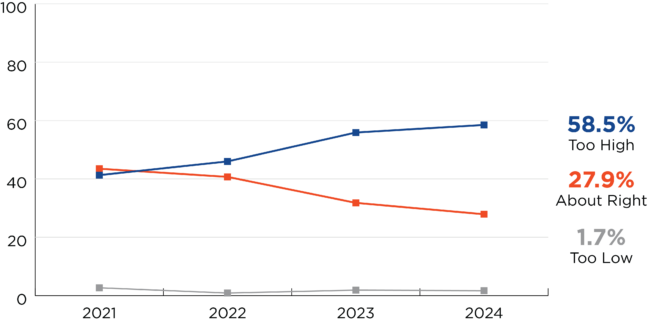
With the U.S. Supreme Court’s overturning of Roe v. Wade, access to abortion is now determined on a state-by-state basis. Currently in Idaho, one section of Idaho Code (§ 18-8804) prohibits any abortion after detection of a fetal heartbeat with exceptions for documented cases of rape, incest, and the life of the mother. This statute was used as the basis for the question asked of survey respondents. Another section of Idaho Code (§ 18-622) prohibits any abortion in Idaho with exceptions for documented cases of rape, incest, and when necessary to prevent the death of the pregnant woman. The statute became effective upon the overturning of Roe v. Wade, but was not accounted for in the wording of the question, which may have impacted responses. While § 18-622 can be read to supersede § 18-8804, both laws remain within current Idaho Code.
After Roe v. Wade was overturned by the Supreme Court, abortion access is now determined on a state-by-state basis. Currently in Idaho, abortion is banned after 6 weeks of pregnancy and the only exceptions are for documented cases of rape, incest, and the life of the mother. Knowing this, which policy would you prefer for Idaho?
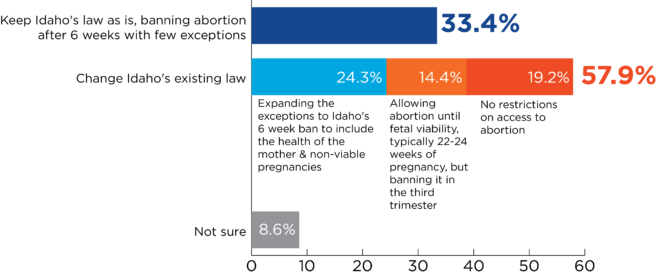
Note: Idaho Code § 18-622 prohibits any abortion in Idaho subject to certain exceptions. This was not reflected in the wording of the question, which may have impacted responses.
One-third of Idahoans (33%) favor keeping Idaho’s law as described in the question (i.e., banned after six weeks with exceptions), which was the largest single response category. Even so, 58% of Idahoans prefer to expand exceptions. Just under a quarter of Idahoans (24%) favor expanding the exceptions to include the health of the mother and non-viable pregnancies. About 14% favor allowing abortion until fetal viability (typically 22-24 weeks of pregnancy), but banning it in the third trimester. Nearly one in five Idahoans (19%) favor no restrictions on access to abortion of any kind.
There was a strong partisan effect on this question, with Republican and Democrat responses being reverse-images of each other. A majority of Republicans (53%) favor keeping the law as described, followed by expanding exceptions to include the health of the mother (26%), up until the third trimester (8%), and having no restrictions (6%). Conversely, more Democrats favor no restrictions (40%), followed by allowing it until the third trimester (29%), expanding exceptions to include the health of the mother (21%), and maintaining the law as described (7%). While the overall order of preference did not differ according to gender, the magnitude of those choices did. More men preferred keeping the law as described (38%), which was distantly followed by expanding exceptions to include the health of the mother (22%), no restrictions of any kind (17%), and banning it in the third trimester (14%). Among women, the top response was also the existing law as described (29%), but it only narrowly exceeded expanding exceptions (27%). It was followed by no restrictions (21%) and banning it in the third trimester (15%).
Who should be responsible for choosing the books that are made available in public libraries is another policy issue that has garnered much discussion in recent years. When asked their level of trust in public libraries and librarians to make these decisions in Idaho public libraries, 69% of Idahoans said they had some (33%) or a lot of trust (37%). Conversely, 23% of Idahoans say they do not have very much (15%) or no trust (8%). A handful of Idahoans (8%) were not sure. Overall levels of trust are high across all political parties, exceeding 60% regardless of party identification. Trust among Republicans is more subdued, as only 26% say they have a lot of trust compared to Independents (40%) and Democrats (58%). Geographically, respondents in northern Idaho had the lowest percentage of overall trust (64%), while the Twin Falls area had the highest (74%).
How much trust do you have in public libraries and librarians to choose the books that are made available at Idaho public libraries?
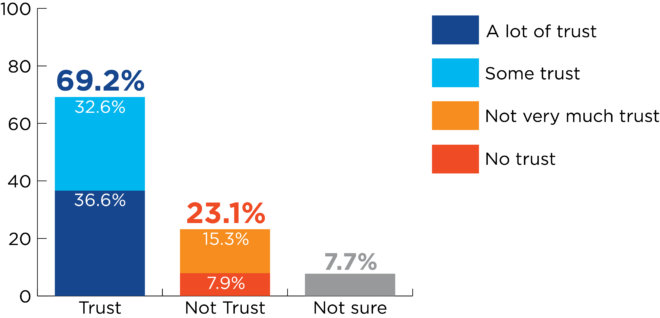
Public Safety
Public safety is one of the chief responsibilities of governments, including the consequences facing those who break the law. When asked about their opinions on mandatory minimum sentencing for drug arrests, a quarter of Idahoans (25%) believe all drug cases regardless of substance should have mandatory minimum sentences, while nearly half (48%) feel mandatory minimum sentences should only be attached to some drug cases, such as those involving fentanyl or heroin. A smaller number (18%) say no drug cases should have mandatory minimum sentences.
For drug arrests in Idaho, which comes closest to your opinion about mandatory minimum sentencing?
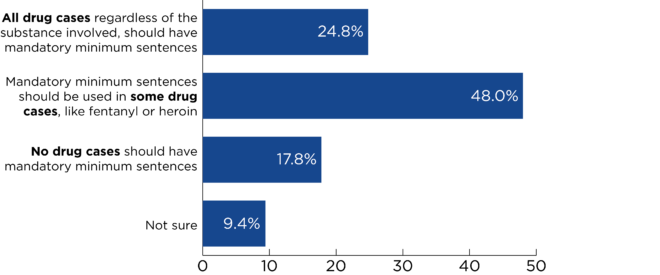
Mandatory minimum sentencing in fentanyl and heroin cases was the most popular response among all parties– Independents (52%), Republicans (47%), and Democrats (44%). When it comes to the second highest response, while Democrats (28%) and Independents (23%) were more likely to say no drug cases should have mandatory minimum sentences, Republicans were more likely to prefer mandatory minimum sentences for every drug arrest (34%).
According to the FBI’s Uniform Crime Reporting (UCR) program, in 2022 there were approximately 2.4 violent-crime incidents per 1,000 people in Idaho and 9.3 property-crime incidents per 1,000 people, although these data only include crimes known to the police. In order to better assess Idaho’s victimization and reporting rate, we asked Idahoans if they had been the victim of a property or violent crime in the past year. While 92% of respondents indicated that they had not been a victim, 4% said that they had been the victim of a property crime, 1% the victim
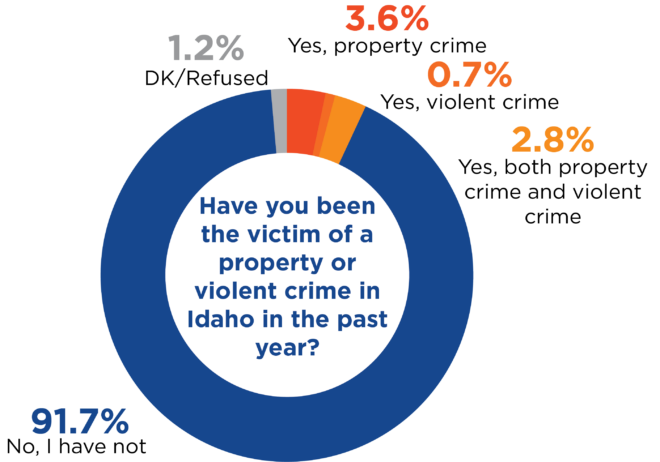
of a violent crime, and 3% the victim of both a property crime and a violent crime.
Among those who reported being the victim of a crime, 62% said they had reported it to the police, while 34% had not. Violent crimes were more likely to have been reported – 71% of those who experienced a violent crime and 57% of those who experienced both a violent crime and property crime said they reported it. Likewise, 64% of those who experienced property crime reported the incident.
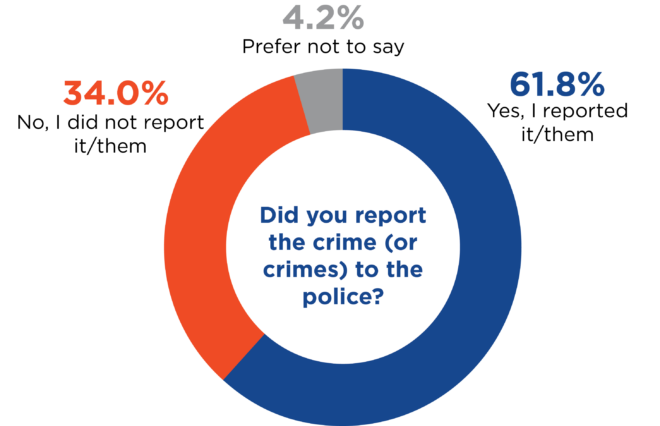
Several resources are available for victims of crime, including counseling, support groups, victim compensation, or help with the criminal justice process. Among those who reported being the victim of a crime, 21% reported receiving some form of assistance, while a majority (76%) did not.
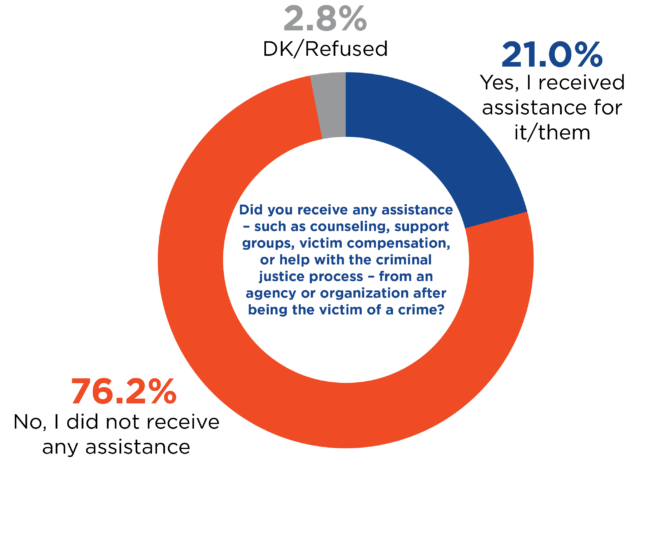
Education
Each year, we ask Idahoans to rate the quality of education in Idaho’s K-12 public schools both statewide and in their own district using a scale of excellent, good, fair, or poor. This year, the most frequent response among Idahoans was once again fair (37%), which is a slight increase from last year, although within the margin of error. Less than a third of Idahoans rated the quality of K-12 education in the state as good (29%) and just under a quarter as poor (24%). Few Idahoans rated the quality of K-12 public school as excellent (4%), the same proportion as last year. Independents are the most critical in their assessment, with 70% rating its quality fair or poor, followed by 65% of Democrats and 50% of Republicans. Those with a child or grandchild in a K-12 school in Idaho were also more likely to rate schools as excellent or good (39%) compared to non-parents (28%).
How would you rate the quality of education in Idaho’s K-12 public schools?
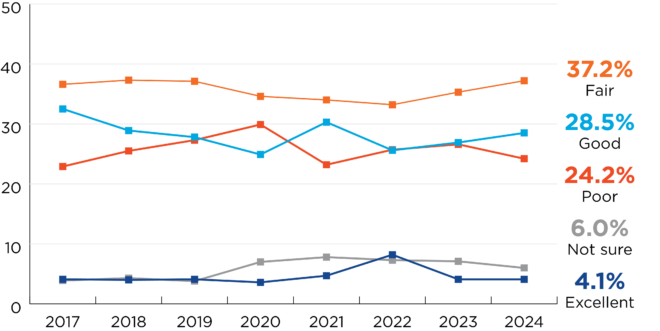
To better understand the reason for less favorable assessments of K-12 public schools in Idaho, this year we posed an open-ended follow-up question to those who responded fair or poor, asking them to identify why. Open-ended responses were coded into like categories. Results are generally consistent with education priorities identified in last year’s survey. The most frequent responses cited quality of education/curriculum (31%), followed by low test scores and ratings compared to other states (17%), lack of funding/improvements (17%), and teacher pay (15%). The remaining response categories all fell below 5% individually and included liberal ideas or woke culture (4%), overcrowding and class size (3%), and the quality of teachers and administrators (3%).
What specifically makes you say that K-12 public schools in Idaho are fair or poor? [open ended]
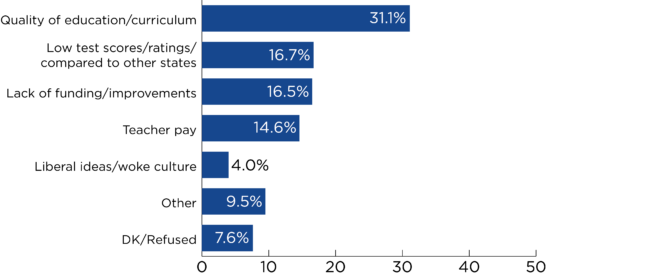
Idahoans are once again more positive when asked about their own school districts rather than the state as a whole, although ratings have not changed much relative to last year’s assessment. About 9% rated the quality of their school district as excellent, 34% as good, 31% as fair, and 15% as poor. All responses fall within the margin of error compared to last year. Republicans have a more positive view of the quality of education in their school district, with more than half (51%) rating it excellent or good, compared to Democrats (43%) and Independents (39%). Parents and those with a child or grandchild in K-12 schools in Idaho also had a more positive assessment (53%) in their own school district compared to non-parents (37%).
Thinking specifically about your school district, how would you rate the quality of K-12 public schools in your area?
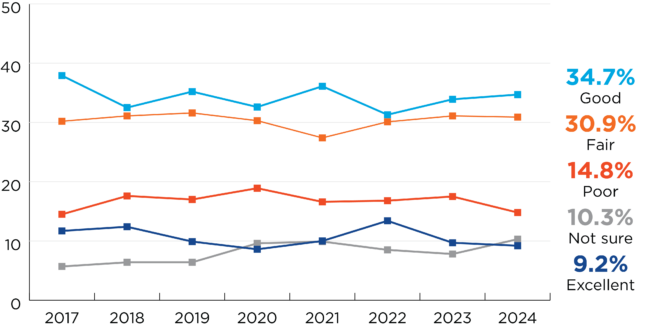
Currently in Idaho, the state government spends approximately $8,000 per student to pay for K-12 public schools. We asked respondents whether they would favor or oppose a plan to allow Idaho parents to take that $8,000 out of the public school system and use it to enroll their child in a private or religious school. Just under half of Idahoans (49%) say they would be in favor of such a plan, while 41% are opposed. There is a strong party effect on support, as a majority of Republicans support (59%) the plan while a majority of Democrats oppose (65%) the plan. Independents are more evenly split, with 46% in favor and 45% opposed.
Right now, in Idaho, the state government spends about $8,000 per student to pay for K-12 public schools. Would you favor or oppose a plan to allow Idaho parents to take that $8,000 out of the public school system and use it to enroll their child in a private or religious school?
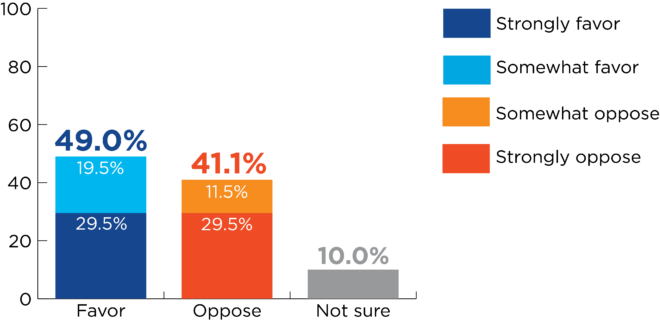
Asked if their support for this plan would change if it could leave some public-school districts with lower overall budgets, 42% of Idahoans said they would be less supportive and only 13% said it would make them supportive. About 42% said it would not have any impact on their support.
When responses for both questions are considered together, we are able to identify the proportion of Idahoans who may actually change their previously stated position. About 12% of Idahoans initially favored the plan but said they would be less supportive if it adversely affected public school budgets, while only 3% initially opposed the plan but said they would be more supportive if it adversely impacted public school budgets. These results suggest that overall public support for the plan likely depends on its funding impact for public schools and the specifics of plans.
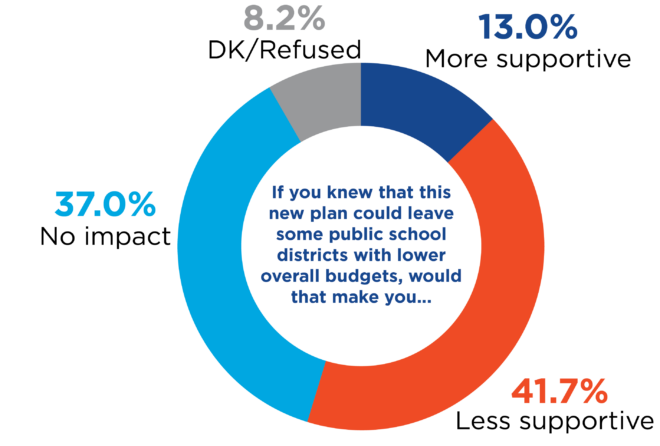
Growth, Housing, and Economic Situation
Growth remains a major issue facing Idaho and increasing attention is being paid to any differences that may exist between longtime Idaho residents and more recent arrivals. About 81% of respondents indicated they were longtime residents, having lived in Idaho for 10 years or more, while 19% reported moving to the state within the past decade. A small proportion of these newcomers (3%) were born in Idaho but had lived somewhere else before returning.
While historically the demographics of new arrivals has looked similar to longtime residents, we are beginning to see a partisan split emerge between the two groups. While 35% of longtime Idaho residents identify themselves as Republicans, nearly half (47%) of new arrivals do – a seven-point increase among new arrivals compared to last year and an 11-point increase from two years ago. Similarly, 39% of longtime residents identify themselves as Independents compared to 29% of new arrivals, a five-point decrease among new arrivals from last year and a 13-point decrease from two years ago. A similar number of longtime residents (16%) and new arrivals (14%) identify as Democrats, with year-to-year changes falling within the margin of error.
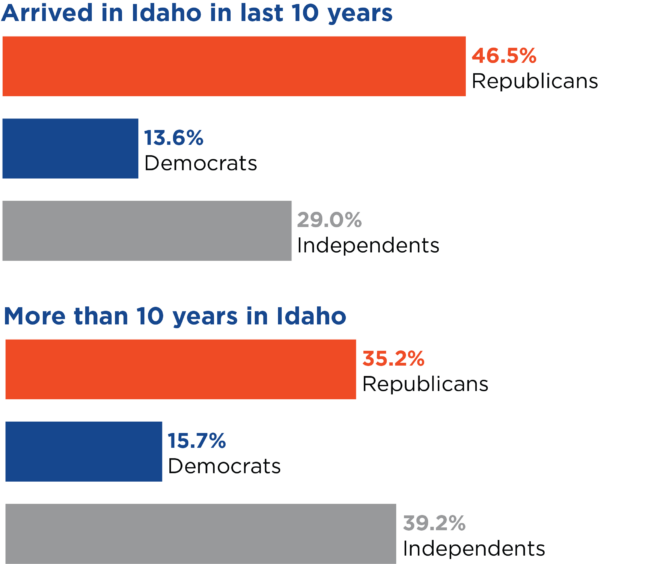
Regardless of how long they have lived here, Idaho residents continue to report concerns regarding issues surrounding growth, housing, and economic security. For a third consecutive year, we asked Idahoans whether they feel that the state of Idaho is growing too fast, too slow, or about right. Once again, over two-thirds (69%) indicated that the state was growing too fast, a two-point increase over the previous year. A little under a quarter (23%) said it was growing about right, a one-point decline over last year, while few (3%) said it was growing too slow.
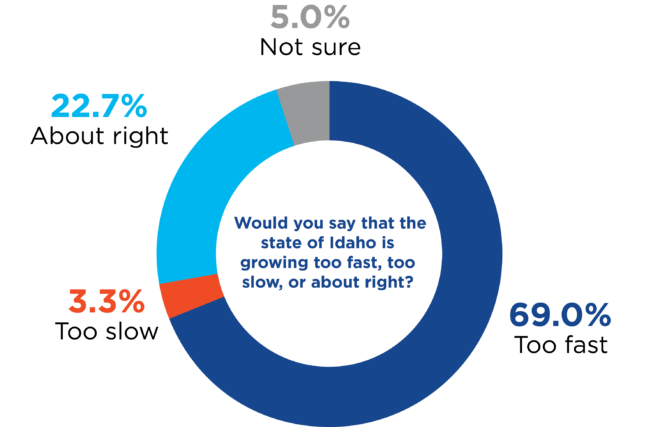
New arrivals to Idaho are nine-points less likely to say the state is growing too fast (62%) when compared to longtime residents (71%). Rapidly growing areas of the state like Canyon County (84%) and Kootenai County (79%) report the highest level of concern that the state is growing too fast, while rural respondents, like those in the Idaho Falls region, report lower levels of concern (63%).
Population growth in Idaho continues to impact housing markets across the state. As such, housing affordability is a challenge for many Idahoans. Case in point, just over half (51%) indicate the cost of housing is placing a financial strain on them and their family. In some instances cost impacted Idahoans’ abilities to remain in their home. When asked if they had to move within the last year due to increasing housing costs, 9% report having to move out of their primary place of residence.
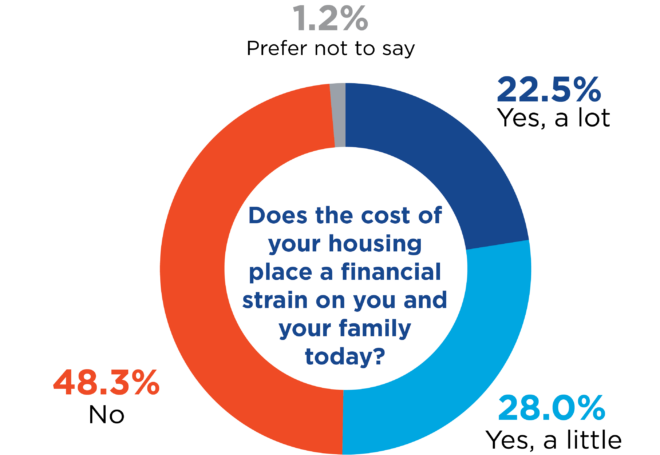
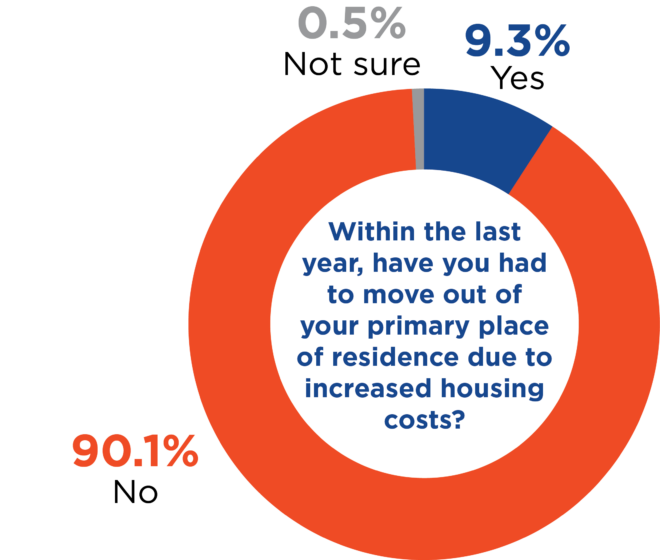
Idahoans continue to be doubtful about the prospect of changing their housing situation with 75% reporting it is unlikely they would be able to do so, a six-point increase from last year.
If you had to move out of your home today for whatever reason, how likely is it that you would be able to purchase or rent a similar home for the same amount?
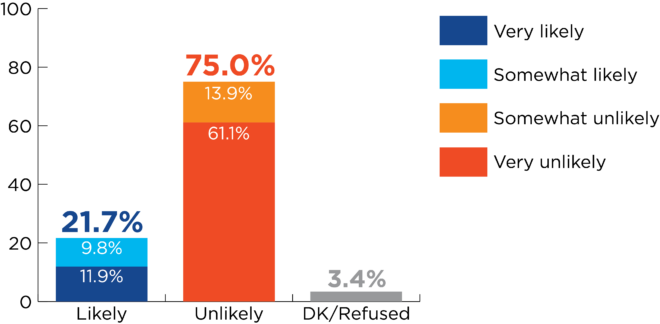
Idaho renters (27% of respondents) typically face a greater housing burden than homeowners (67% of respondents). Renters are far more likely to report housing costs placing a financial strain on their families (76%) than homeowners (39%). Likewise, renters are also impacted at a higher rate than homeowners when it comes to finding similarly priced homes, with 81% of renters saying they are unlikely to do so compared to 72% of homeowners, a nine-point difference.
Elections
Numerous changes to Idaho’s election laws are currently under consideration. One such proposal is the creation of a state-issued voter guide. Voter guides provide background information on the candidates and list who you can vote for with a description of each candidate’s experience and goals. They can also explain ballot measures, which are specific questions or issues that you as a voter can approve or reject. Typically candidate profiles and ballot measures would be sent to the Secretary of State. Given this background information, 78% of Idahoans say they favor a state-issued voter guide (48% strongly favor), while 10% are opposed (5% strongly opposed). Support is strong (over 80%) across all political parties.
Idaho is considering creating a state issued voter guide. Voter guides provide background information on the candidates and list who you can vote for with a description of each candidate’s experience and goals. They can also explain ballot measures, which are specific questions or issues that you as a voter can approve or reject. The candidate profiles and ballot measures would be sent to the Secretary of State. Knowing this, would you favor or oppose a state issued voter guide?
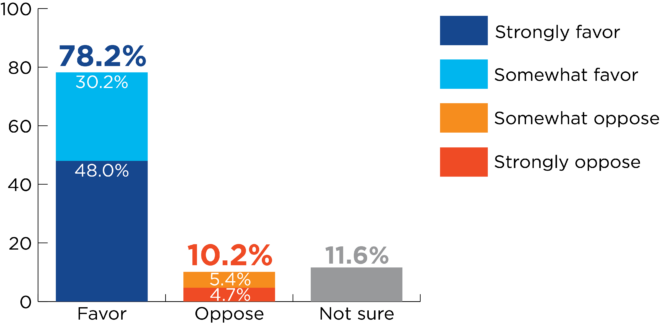
Three years ago, following the 2020 presidential election, we asked Idahoans if they had any concerns about the security of Idaho elections. A majority of Idahoans at the time said they did not have concerns. As we enter another presidential election cycle, we revisited this question to see if Idahoans’ opinions have changed over time. Two-thirds of Idahoans (67%) said they do not have concerns about the security of Idaho’s elections, down 10-points from three years ago. Conversely, nearly a quarter (23%) said yes, they do have concerns, which is up four-points. About 10% of Idahoans remain unsure (a five-point increase).
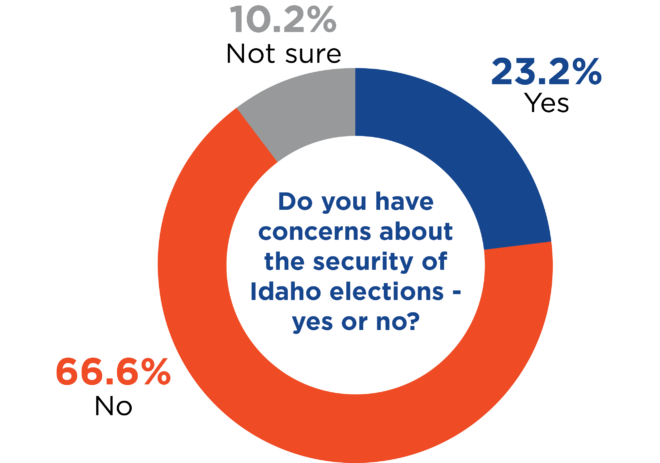
Election security concerns were highest among Republicans (27%), followed by Independents (23%), and lowest among Democrats (12%). Regionally concern was highest in the Twin Falls area (28%) and northern Idaho (26%). Concerns were also more pronounced among those who view the state as off on the wrong track (by 10-points) and those who do not trust public libraries (by 20-points).
Following a 2023 decision by the Idaho Legislature to eliminate March elections, an unintended consequence left Idaho voters without a presidential primary going into the 2024 U.S. presidential election cycle. This has resulted in debates between state-run primary elections vs. party-run caucuses, as well as whether the presidential primary should remain split from state-level primary elections in May.
To the first issue, we asked Idahoans whether they prefer a primary election, in which residents cast their ballots for a candidate either in-person or absentee, or a caucus, where a local gathering is held and voters decide who to support in-person only. Most Idahoans overwhelmingly favor a primary election (74%) over a caucus (13%). Preference for a primary election holds true regardless of party affiliation, although support for a caucus was highest among Republicans (16%) followed by Independents (14%) and Democrats (8%). Support for a caucus was 16-points higher among those concerned about the security of elections compared to those who are not. Support for a primary also increases with age, rising from 67% among those aged 18-39 to 75% among those aged 40-64 and 81% among those aged 65 or older.
For Idaho primary elections, would you prefer a primary election in which residents cast their ballots for a candidate either in-person or absentee, or would you prefer a caucus where a local gathering is held and voters decide who to support in-person only?
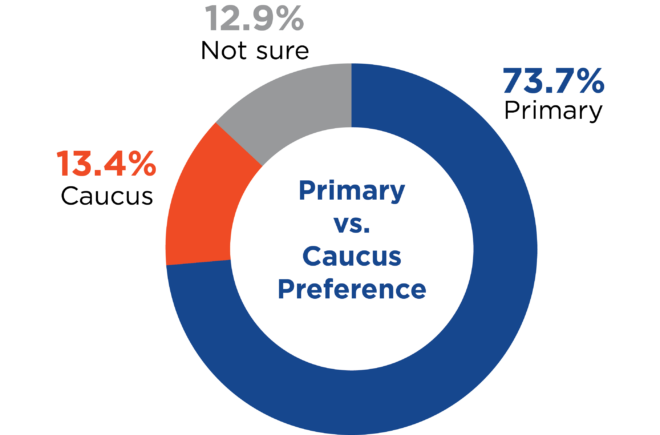
To the second issue, when asked whether they would prefer having both the presidential and state-level primaries together on the same day or on separate days, a similar majority of Idahoans said they would prefer the two primaries to be held together (74%). Only 17% said they would prefer the two contests to be held on separate days. Support for holding the primaries on the same day was highest among Republicans (80%), followed by Democrats (76%) and Independents (74%).
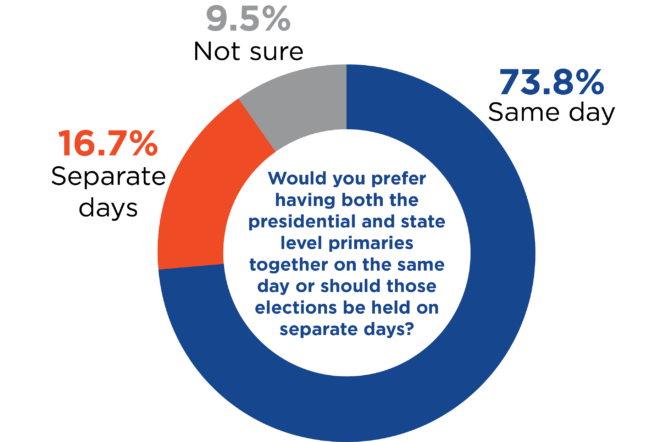
Another election reform under consideration in Idaho would institute a top-four system for the primary election and a ranked-choice ballot system for the general election. We sought to measure Idahoans’ opinions on each of these systems independently.
First, a top-four primary system would allow all voters to use one ballot with all candidates listed, regardless of the candidate’s or the voter’s political affiliation. Each voter would vote for one candidate and the four candidates who receive the most votes would advance to the November general election, regardless of party affiliation. Knowing this, 58% of Idahoans say they would favor a top-four system in Idaho (29% strongly, 29% somewhat), while 27% say they would oppose it (17% strongly, 9% somewhat).
A top-four primary system would allow all voters to use one ballot with all candidates listed, regardless of the candidate’s or the voter’s political affiliation. Each voter would vote for one candidate and the four candidates who receive the most votes would advance to the November general election, regardless of party affiliation. Knowing this, would you favor or oppose a top-four primary system in Idaho?
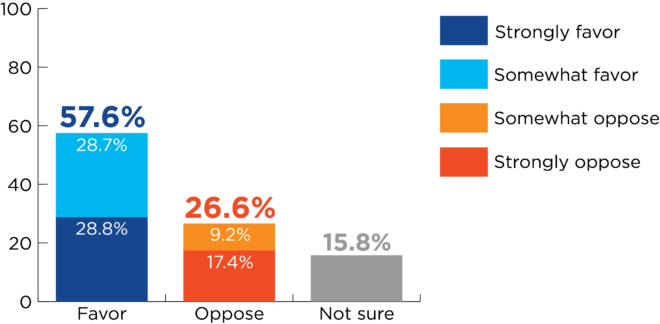
Respondents from all political parties were favorable, with majorities of Democrats (65%) and Independents (64%) supporting the top-four system and a plurality of Republicans (49%). Support declined 12-points among those with concerns over the security of Idaho elections. It also declined nine-points with age, going from 61% favorability among those aged 18-39 to 58% among those aged 40-64 and 52% among those aged 65 and older.
Alternatively, a ranked-choice voting system would ask voters to rank the candidates in their order of preference. When votes are counted, if a candidate receives more than 50% of the vote, they are declared the winner. If no candidate receives more than 50% of the vote, the candidate with the least number of votes is eliminated and their votes are reallocated to each voter’s next preferred candidate, with this process repeating until a candidate receives more than 50% of the vote. If a voter only indicates one preferred candidate and that candidate is eliminated, their votes will not be used in calculating the 50% threshold in successive rounds. Knowing this, only 35% of Idahoans say they would favor a ranked-choice voting system in Idaho, while half (50%) would oppose it.
Opposition to ranked-choice voting was the top response among all political parties and was highest among Republicans (61%), followed by Independents (47%) and Democrats (45%). Opposition also increased with age, rising from 37% opposed among those aged 18-39 to 54% opposed among those aged 40-64 and finally to 61% opposed among those aged 65 and older.
A ranked-choice voting system would ask you to rank the candidates in your order of preference. When votes are counted, if a candidate receives more than 50% of the vote, they are declared the winner. If no candidate receives more than 50% of the vote, the candidate with the least number of votes is eliminated and their votes are reallocated to each voter’s next preferred candidate, with this process repeating until a candidate receives more than 50% of the vote. If a voter only indicates one preferred candidate and that candidate is eliminated, their votes will not be used in calculating the 50% threshold in successive rounds. Knowing this, would you favor or oppose a ranked-choice voting system in Idaho?
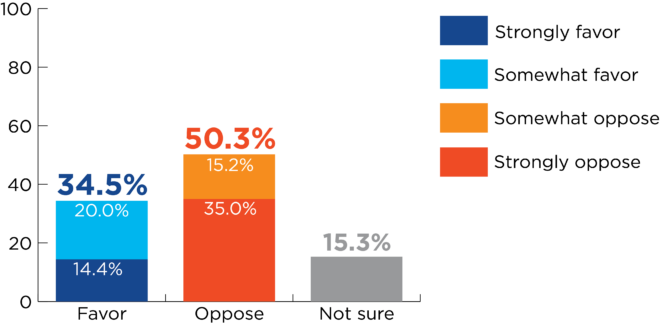
When comparing top-four support by ranked-choice support, 29% of Idahoans indicated they would favor both a top-four primary system and a ranked choice voting system; 6% said they would only favor a ranked-choice voting system; 29% said they would only favor a top-four voting system; and 23% said they were opposed to both systems. The remaining 14% of respondents expressed uncertainty about the systems.
Conclusion
This ninth edition of the Idaho Public Policy Survey has explored Idahoans’ attitudes and preferences on a wide range of policy issues facing the state. Building on results from prior years, it has allowed us to identify a trend of increasing economic concerns and pessimism among Idaho residents about the future, while also allowing us to deepen our understanding and explore why this might be the case.
Critically, it has also given Idahoans a chance to articulate their preferences on the public policy issues of the day, be they legislative priorities, tax relief, education proposals, abortion policy, or election reforms. Understanding the attitudes and concerns of their constituencies enables Idaho’s policymakers to take these perspectives into account when crafting solutions for the state.